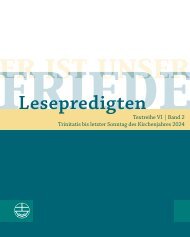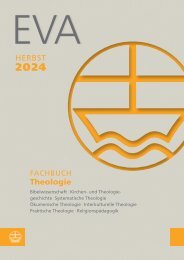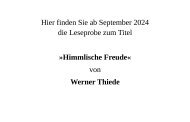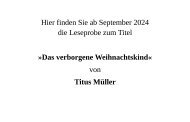Phillip A. Davis, Jr. | Daniel Lanzinger | Matthew Ryan Robinson (Eds.): What Does Theology Do, Actually? (Leseprobe)
You also want an ePaper? Increase the reach of your titles
YUMPU automatically turns print PDFs into web optimized ePapers that Google loves.
Note on the Cover Photographs<br />
The cover of this book features four photographs. Choosing the photographs<br />
prompted some discussion concerning the nature and purpose of cover artwork.<br />
<strong>What</strong> does it say? Who or what does it represent, and who has a say in this? How<br />
can method and interpretational diversity be accounted for or responsibly reflected?<br />
Art does not trade in the syllogistic logics of linear argumentation. As<br />
such, works of art remain open to interpretation. And yet, the curatorial choice<br />
for these photographs, once made, is final. There is no opportunity, in the case of<br />
cover artwork, to develop a critical discussion; ongoing dialogue is silenced.<br />
<strong>What</strong> is an appropriate balance, then, between saying too much and not enough?<br />
Recognizing that, while they invoke associations, the images are not selfinterpreting,<br />
the following notes are meant to stimulate reflection on their meanings<br />
individually and corporately. Positioned under the title, being the statement<br />
of the question, ‘‘<strong>What</strong> does theology do, actually?’’, the photographs presented,<br />
viewed from left to right, might be seen as providing four reflections on things<br />
exegesis has done, does, and might do.<br />
Masoretic Text of the Hebrew Bible. The first image fulfills stereotypical expectations<br />
concerning what exegesis does. Exegetes read and interpret the Bible in its<br />
original languages, study its history of reception, produce critical-textual editions,<br />
and the like.<br />
The Digital as Exegetical Space? The second image experiments with the idea of<br />
scholarship, biblical languages, and programming languages. The image thus<br />
queries what kind of things exegesis will do, what questions it will ask, how<br />
knowledge will relate to data, and how much knowledge production will depend<br />
on access to technological resources in the future.<br />
The Tower of Babel. The third image problematizes the layering of pasts and presents<br />
in biblical exegesis by layering the world of the historical text with the<br />
history of the text in the world. Babel can be regarded as a multilayered exegetical<br />
metaphor. Babel is in one sense an etiology of hermeneutics as starting with
















